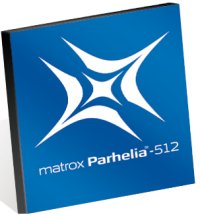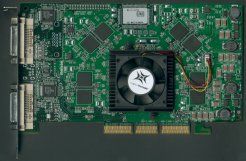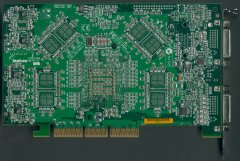Product: Matrox Parhelia 128MB
Chipset: Matrox Parhelia

Frankly, to many Matrox have been looking sickly for some time. Their last major release, G550, did nothing to excite the hardware enthusiast community, with its 'Headcasting' technology almost looked upon with derision. Matrox's much talked of G800, which was touted as being "twice as fast as G400", never materialised, seeing as many other chips had already far exceeded twice the performance of G400. During this period Matrox retreated into their known and trusted workstation/professional market, yet with the big players ever encroaching on all the available graphics markets out there Matrox needed something else.
And so it was that in May 2002 Matrox announced the Parhelia-512 GPU, an all new chip designed to interest gamer and professional alike. However, as soon as the benchmarks hit the web things did not seem all that fine again as the new Matrox entrant had trouble shining in terms of performance against NVIDIA's GeForce4 Ti, let alone what was in store from ATI a few more month down the line. Was this performance down to immaturity of drivers, or was the hardware too slow? In this review we'll take a look at some early drivers and see how things have evolved with their latest driver updates. We'll also see what else Parhelia has to offer that other boards don't...
Note: The 128MB board has 8 BGA memory chips on the front side of the board to facilitate the 128MB 256bit bus. The back side of the board clearly shows the slots where extra BGA chips can be placed directly behind those on the front side of the board to increase the amount of RAM. Indeed Matrox now have a 256MB version of Parhelia available.
Parhelia Technology
Here's a quick rundown of the key chip specifications:
- 80 Million Transistors
- UMC 0.15µ process
- 220MHz Core clock speed
- 4 Pixel Pipes
- 4 Texture units per pipe
- 880M pixel/s, 3520M texels per sec
- 275MHz DDR RAM (550MHz effective)
- 256 bit memory bus
- 17.6GB/s Memory bandwidth
- AGP4X
220MHz is relatively slow in comparison to many other boards out there, though at the time of release it was generally thought by many that, as Parhelia was the biggest chip of the time, the 0.15µ process wouldn't allow for much more. This was proved to be incorrect some months later by ATI's behemoth R300 chip. However, with a 256-bit bus, as also used by ATI with Radeon 9700 and 3Dlabs with Wildcat VP, there were high hopes that this would be the answer to what was often thought as the biggest issue with contemporary 3D graphics: memory bandwidth.


